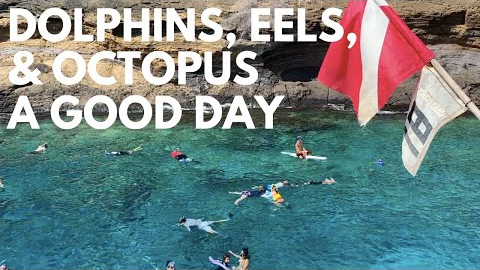Molokini Snorkeling Tour (Maui) | Is a Molokini Crater Snorkel Trip Worth It?
126,355 View
Share this Video
- Publish Date:
- July 15, 2025
- Category:
- Surfing
- Video License
- Standard License
- Imported From:
- Youtube
Tags

Molokini Crater snorkeling is a top thing to do when vacationing on Maui, but is it worth it? One can see amazing marine life with the shoreline snorkeling. But we did see dolphins…
Need to know how to fit this trip and more of our favorite Maui activities into your itinerary? And save money? Download our Maui itinerary for your dream Hawaii vacation: https://thehawaiivacationguide.com/maui/
We put off a trip to Molokini Crater for a year but when Pacific Whale Foundation opened for residents, we couldn’t resist going to Molokini Crater and Turtle Arches on a Pacific Whale Foundation tour.
We put off a trip to Molokini for snorkeling because we thought it wasn’t worth it. We love snorkeling on Maui and one can do great snorkeling for free from the shore. Why get a snorkeling boat to see turtles and fish?
After going, we realized a trip to Molokini Crater is more about the day out on the water. Be it a big boat tour, a sailboat, or a raft, it is a fun day on the ocean if that is what you are looking for in a #Maui or any island on #Hawaii vacation.
We have more things to do and recommendations on our favorite activities on our website. Check out the link below.
Check out more of our Maui and Hawaii itineraries at the link below. All are FREE and full of fun.
https://thehawaiivacationguide.com/itineraries
——————————————————
OUR CAMERA GEAR (keep it simple for your vacation!):
Underwater camera: GoPro HERO 8 https://amzn.to/3wJFuYK
Use your smartphone for video but keep it smooth with a gimbal: OSMO DJI https://amzn.to/2SOIHHJ
Don’t lose your GoPro, invest in a floaty
Floaty stick: https://amzn.to/3zIoggm
Floaty cover: https://amzn.to/3j7uTD5
Vlogging camera (but use your phone for a family holiday): https://amzn.to/3h1QxpF
Molokini Crater and Turtle Arches Snorkeling Tour: Is a Boat Tour Worth the Money?
00:00 Intro
01:09 Why a Molokini snorkel trip may be worth it for you
02:06 Tips on what to bring snorkeling at Molokini
02:47 Debate: Why to to Turtle Town by boat when you can go by shore?
03:45 Breakfast by Pacific Whale Foundation
04:31 Dolphins spotted on the way to Molokini
05:27 Molokini Crater Facts
06:45 Molokini Snorkeling footage (eel and turtle included)
10:01 Pu’u Olai Beach Snorkeling
11:12 Lunch by Pacific Whale Foundation
Recommendation on Snorkel Gear:
Before you rush out to buy snorkel gear, we recommend renting when on the islands. Save on luggage space by renting. There are a lot of great, local renting shops on all the islands. Prices range from $1.50 a day to $6 day. One can get discounted rates by renting for the week. With a local shop, you can make sure you get quality snorkel gear and they can fit the mask properly. Many resorts also provide snorkel gear!
If you are still eager to purchase, here are our favorite snorkel gear sets that are travel-ready and fit very well! They are well-priced for the quality. https://thehawaiivacationguide.com/hawaii-recommendations/hawaii-travel-gear/
Click Subscribe to get notified on more Hawaii adventures and tips on traveling to Hawaii (plus subscribing helps us out!).
Disclaimer. Your use of the information provided in our Content, Itineraries, Site and Services is for your informational purposes only and is subject to our Privacy Policy and Terms of Service. Your use of the information described in, your participation in activities presented in, and/or your engagement of any Travel Service Providers presented in our Content, Itineraries, Site and/or Services may carry the risk of illness, bodily injury, disability, death, or property damage. You voluntarily and freely assume all risks and dangers that may occur pursuant to your access, use, purchase or participation in any information, activity, good or service described in our Content, Itineraries, Site and Services or provided by any Travel Service Providers.
Terms of Service: https://thehawaiivacationguide.com/terms-conditions/
Privacy Policy: https://thehawaiivacationguide.com/privacy-policy/
Credits:
Molokini Crater Photo by Farid Askerov on Unsplash
——————————————————
Follow us on Instagram for behind the scenes content: @thehawaiivacationguide https://www.instagram.com/thehawaiivacationguide/
——————————————————
Sign up for our Hawaii Opens Update email here - https://thehawaiivacationguide.com/newsletter/
——————————————————
POPULAR VIDEOS
The Best Hawaiian Island for First-Timers video - https://www.youtube.com/watch?v=niOXH...
Lahaina, Maui Ghost Town Bike Ride (April 3rd, 2020) - https://www.youtube.com/watch?v=VPiZL...
Where to Stay in Hawaii: Hotels vs Vacation Rentals - https://www.youtube.com/watch?v=wgg_4...
-----------------------------------
Barrier Builders: Tidal Sediment and Erosion Sculpting Coastal Sandbar Formations and Shoals
Understanding Sandbar Formations
Sandbar formations are fascinating natural structures that play a crucial role in shaping our coastal landscapes. These underwater ridges, composed primarily of sediment, are formed by the continuous action of tides and currents. As tidal waters move in and out, they transport and deposit sediment, gradually building up these barriers and shoals that define the coastal regions.
The Role of Tidal Forces
Tidal forces are the primary drivers behind the formation of sandbars. The ebb and flow of tides create dynamic water movements that redistribute sediment along the coastline. During high tide, water levels rise, allowing sediment to spread out, while low tide exposes these sediments, leading to their accumulation in specific areas. This cyclic process is essential in shaping the barriers and shoals that protect inland areas from the direct impact of ocean waves.
Sediment Distribution and Coastal Protection
Sediment plays a pivotal role in the development of sandbar formations. The size, type, and availability of sediment materials determine the stability and growth of these structures. Fine sands tend to form extensive, gentle sandbars, while coarser materials can lead to the creation of more resilient and pronounced barriers. These sandbars act as natural buffers, absorbing wave energy and reducing coastal erosion, thereby safeguarding coastal ecosystems and human settlements.
Erosion and its Impact on Sandbar Stability
Erosion is a natural process that influences the longevity and shape of sandbar formations. Strong wave action and storm events can erode these barriers, altering their structure and position. However, erosion also contributes to the continuous reshaping and dynamic nature of coastal environments. Understanding the balance between sediment deposition and erosion is key to managing and conserving these valuable coastal features.
Barriers and Shoals: Distinguishing Features
While often used interchangeably, barriers and shoals have distinct characteristics. Barriers are elongated landforms that run parallel to the coastline, providing significant protection from oceanic forces. Shoals, on the other hand, are elevated areas of shallow water that can extend offshore, posing navigation challenges but also contributing to coastal protection. Both barriers and shoals are integral components of the complex interplay between tidal movements, sediment supply, and coastal dynamics.
The Future of Sandbar Formations
As coastal areas face increasing pressures from human activities and climate change, understanding the formation and maintenance of sandbars becomes more critical. Sustainable coastal management practices are essential to preserve these natural barriers, ensuring they continue to provide protection and maintain the ecological balance. Future research and innovative conservation strategies will play a vital role in safeguarding sandbar formations for generations to come.
Did you miss our previous article...
https://trendinginhawaii.com/surfing/town-surf-spots-explained-south-shore-oahu











